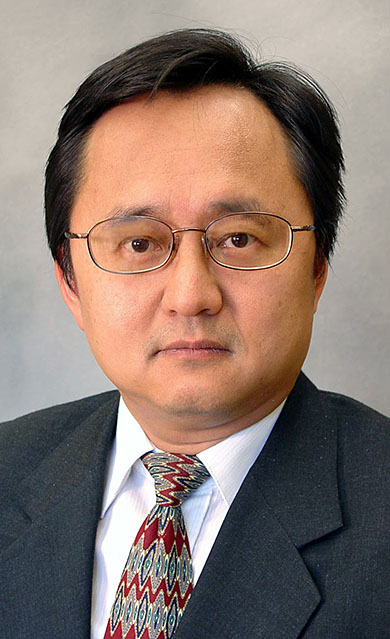Music of the spheres and ellipsoids
Music of the spheres and ellipsoids
| Author: | Eric Bender |
|---|---|
| Magazine Section: | Innovate |
| College or School: | CoE |
| Article Type: | Issue Feature |
| Page CSS: | #article-banner { background-position: center 20% !important;} |
| Feature Intro: | Sangtae Kim solves a longstanding challenge in fluid dynamics decades after taking it on. |
Here’s the puzzle:
As a small sphere moves through a fluid, the forces on its surface known as surface traction can be described by a relatively simple equation: The surface traction equals a constant times the sphere’s “rigid body motion,” in which an object is assumed to maintain its shape without deforming.
Curiously, as an ellipsoid moves sideways through a fluid, its surface traction follows the same type of simple mathematical pattern, although an ellipsoid is a far more complex shape than a sphere.
In fact, the equation that covers an ellipsoid’s sideways motions in a fluid also works for an ellipsoid’s rotational motions.
Just why do these simple equations do so much?
This case of the curious simplicity has been a 140-year-old mystery with key plot developments in 1876, 1892 and 1964, says Sangtae Kim, the Jay and Cynthia Ihlenfeld Head of Chemical Engineering and the Donald W. Feddersen Distinguished Professor of Mechanical Engineering and of Chemical Engineering.
And now we can add 2015.
After pondering this enigma off and on for more than 35 years, in the summer of 2015 Kim solved it, coming up with what he calls a “short and simple proof.”
In the process, he also solved a more general mathematical problem. These discoveries will allow the development of new computational tools to describe the behavior of nanoparticles in fluids — with applications in pharmaceutical discovery and other industrial uses.

Gaining surface traction
In the 1860s as the British mathematician George Stokes laid the groundwork for understanding the sideways or rotational movement of spheres in fluid, he found that the sphere’s surface traction can be described by its rigid body motion times a constant.
The German physicist Anton Oberbeck followed up in 1876 by showing that for an ellipsoid moving sideways through a fluid, surface traction is the product of the rigid body motion times the “dot product” of two vectors. (As you may recall from your pre-calculus classes, a dot product is an algebraic operation that returns a single number from two equal-length sequences of numbers.)
In a traveling ellipsoid, one of the dot product’s vectors is perpendicular to the local tangent at a given point on the surface, and the other is the position vector from the center of the ellipsoid to that point on the surface, Kim explains.
Many years later, in 1892, the rotation ellipsoid problem was solved by the British mathematician David Edwardes. Remarkably enough, the surface traction was described by this exact equation.
Now fast-forward quite a few decades. “The person who pointed out this amazing simplicity, and really unified all of these simplicities, was Professor Howard Brenner, in a classic 1964 paper,” Kim says. “This is the paper I read back in the 1970s when I was an undergraduate at Caltech.”
But the teenage Kim felt that Brenner’s proof, while correct, lacked elegance and didn’t quite get to the heart of the problem.
“The rotating ellipsoid proof takes twice as many pages of algebra as the ellipsoid translation proof,” he says. “You get this simple result by going through these circuitous, complicated and messy algebraic manipulations. That’s what’s been bothering me since I first came across the proof as a teenager.
“You could say I’ve been working on this problem for more than 35 years.”

Off the backburner
After gaining a PhD from Princeton in chemical engineering, Kim taught at the University of Wisconsin-Madison for about 15 years, initially focusing his studies in fluid dynamics.
A few years later, however, “a number of my colleagues pointed out that the same governing equations that I used to solve the dynamics of a particle in fluid were also applicable to the dynamics of biological macromolecules like proteins and DNA molecules,” he says. “And so my research interests gradually shifted to computational biology.”
Working in his new field, Kim ended up running research computing at two large pharmaceutical companies, and then launching a division for computing infrastructure at the National Science Foundation. In 2005 he returned to academia, first at Purdue, then the University of Wisconsin again, and then back once more to Purdue last year.
Through all the years and his demanding executive positions, “I treated this puzzle as a hobby,” Kim says. “Even when I was in industry and at the National Science Foundation, I always kept track of this problem. Periodically I would return to it and see if I could solve it.”
He began looking more actively for a solution last year after co-organizing a symposium in honor of Professor Brenner, because one of the symposium themes was Brenner’s 1964 paper.
“Finally last June, I was traveling to California to visit a startup company that was doing exciting work in computational drug discovery,” Kim recalls. “While I was in travel, I had a little extra time. I tried a different approach, and that's when I had the breakthrough and solved the problem.”
“I initially wrote down the solution on a napkin, the proverbial napkin, because that’s what was available,” he says. “But I knew it was going to work.”
The successful strategy draws on a branch of mathematics known as abstract metric spaces, which Kim uses in his current work in computer-aided rational drug discovery.
For drug discovery, the similarity or dissimilarity between two molecules is conceptualized as a distance in an abstract metric space, Kim says. The findings about ellipsoid motion build on the same underlying mathematical methods.
The proof appeared in a paper in a special November 2015 issue of Industrial & Engineering Chemistry Research that honors his colleague Doraiswami Ramkrishna, the Harry Creighton Peffer Distinguished Professor of Chemical Engineering at Purdue. Publishing in this special issue was particularly appropriate, Kim says, because Ramkrishna popularized the use of abstract metric space in chemical engineering.
His insights into ellipsoidal motion also “opened the door to significant opportunities in the computational analysis of ellipsoidal particles in nanoparticle technology,” Kim says. “In any mathematical model where researchers are interested in predicting the motion of these nonspherical particles, whether it’s a biological or a nanoparticle problem, there is now a new way of doing the computational problem.”
The eventual triumph may hold a lesson for younger researchers, he says: “Regardless of where your life takes you, there’s something satisfying about having a long-term goal and the opportunity to solve that.”
His achievement also emphasizes the special atmosphere and advantages of academic research. “Luck has an element, but so does the academic freedom of a faculty position to do something that you believe is important,” Kim says. “Your inner fire drives you to seek the solution to a problem, literally 24/7 instead of 9-to-5, because ultimately one aspect of this job is the responsibility to create knowledge.”

Comments